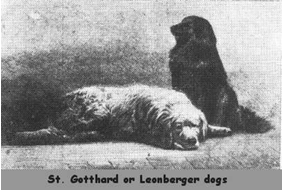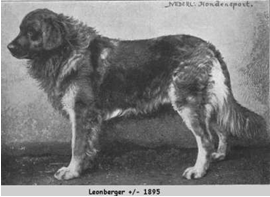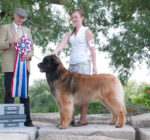The Leonberger was developed by the entrepreneur Heirich Essig (1809-1889), who lived in a small town in Germany called Leonberg, hence the name of the breed.
 Essig was a man of considerable wealth and stature within the community. He was a politician and an alderman, and had the notion to develop a breed of dog that resembled the town’s crest, which was that of a lion.
Essig was a man of considerable wealth and stature within the community. He was a politician and an alderman, and had the notion to develop a breed of dog that resembled the town’s crest, which was that of a lion.
The accounts of which breeds Essig used in the creation of the Leonberger come with some doubts, as Essig did not keep accurate records in the early years and later made claims to have developed the breed by crossing a long haired St Bernard dog with a black and white Landseer bitch. He then crossed the progeny for four generations. He continued and used another St Bernard dog and also a white Pyrenean dog in his development of the Leonberger.
However, there is some concern that the records kept by Essig did not tell the entire story of the development of the breed as the Leonberger head is totally distinct from that of either a St Bernard or a Landseer.
 There are other theories including one that a common European wolf bitch hybrid was used in the establishment of the breed and then a more desired temperament and greater size was obtained from crossing in St Bernard and Landseer dogs.
There are other theories including one that a common European wolf bitch hybrid was used in the establishment of the breed and then a more desired temperament and greater size was obtained from crossing in St Bernard and Landseer dogs.
Either way, by the mid 1800s the Leonberger breed had been established, after which time the majestic lion-like breed became a quite a popular dog with the upper class. The breed was notable as an estate guardian as well as an all purpose farm and family dog.
With Essig’s considerable marketing skills his dogs were sold to many royalty throughout Europe. Early owners of this great breed included Napolean III of France, the Prince of Wales who later became Edward VII, King Umberto of Italy and the Empress Elisabeth of Austria. The dogs were highly prized and it is known that Essig sent 374 Leonberger dogs to Russia in 1873 clearly indicating the large number of dogs he housed and bred. Records show that Essig bred, sold and traded dogs for a period of 50 years, and in some years several hundred dogs were exchanged from his breeding facility.
In Canada
The Leonberger breed was recognized by the CKC in 1992 and has steadily increased in popularity, though still remaining one of the less known breeds of the working group. For the last few years an average of around 140 puppies have been registered per year with the CKC with the largest number in 2008 with 31 litters producing 183 puppies.
